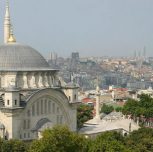The Sultan Selim complex which was built by Suleiman the Magnificient in memory of his father, Yavuz Sultan Selim, during the years 1516-1522 in the Sultan Selim area of the Fatih district on a hill which overlooks the Haliç (Golden Horn). It consists of a mosque, a soup-kitchen (imaret), a Sıbyan mektebi (Ottoman elementary-primary school), a darüşşifa (hospital), a Turkish bath, and a tomb.
Although the builder of the complex is unknown, certain Turkish art historians, such as Tahsin Öz, have asserted that it was built by the architect Acem Ali. It was built by taking samples of mosques in Edirne, and it is one of the last examples of a mosque with hostels. The mosque is situated in the middle of a large outer courtyard, and its enterance faces a cloistered inner courtyard that can be entered through three different directions from the outer courtyard, and which is encircled by 22 domes. There is an extraordinary fountain with eight columns located in the middle of the inner courtyard. The main area of the mosque is covered by a dome of 24.5 meters in diameter. When both the size and height of the dome’s design are taken into a consideration, there is a clear attempt for it to dominate the main space of the mosque.. There is a respondent platform (müezzin mahfili), located on six small colums on the righthand side of the Harim (sanctum sanctorum) and an eye-pleasing Hünkar Mahfili (royal residence) is raised on eight columns on the left hand side. Evliya Celebi, a famous traveller and historian, stated that cages with gilding in the royal residence had been added by Sultan Ibrahim (1615 – 1648). The inlaying used on tile panels, which are located on the door of qibla and on several window arches, adds to the artistic value to these elements. In addition, the inlaid marble pulpit and two minarets with single balconies attract the attention of visitors to this plain mosque.
Another structure of the complex is its tomb, which was built in a classical style and has an octagonal plan with a porched entrance. It contains the sarcophogus of Sultan Selim I (1465-1520), which is placed in the grave of the complex in the direction of the qibla, and a white caftan is hung at the head of the sarcophogus. This famous caftan, which belonged to Sultan Selim I, was splashed with mud by a horse of İbni Kemal,who was a scholar of that period. The children of Suleiman the Magnifient are buried in the other tomb, which has the same architectural characteristics asthe first one. Morover, Hafsa Sultan, the mother of Suleiman the Magnifient, is buried in the graveyard of the complex. A mosque, tombs, and Sıbyan Mektebi, built at the entrance of outer courtyard, are the structures which still exist today.










